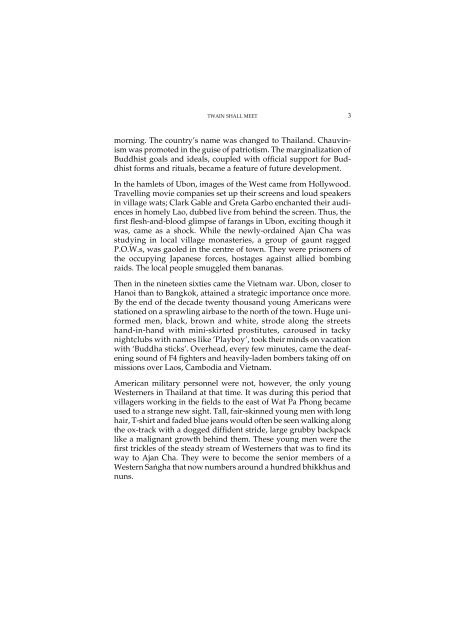Forest Path - Amaravati Buddhist Monastery
Forest Path - Amaravati Buddhist Monastery
Forest Path - Amaravati Buddhist Monastery
You also want an ePaper? Increase the reach of your titles
YUMPU automatically turns print PDFs into web optimized ePapers that Google loves.
twain shall meet 3<br />
morning. The country’s name was changed to Thailand. Chauvinism<br />
was promoted in the guise of patriotism. The marginalization of<br />
<strong>Buddhist</strong> goals and ideals, coupled with official support for <strong>Buddhist</strong><br />
forms and rituals, became a feature of future development.<br />
In the hamlets of Ubon, images of the West came from Hollywood.<br />
Travelling movie companies set up their screens and loud speakers<br />
in village wats; Clark Gable and Greta Garbo enchanted their audiences<br />
in homely Lao, dubbed live from behind the screen. Thus, the<br />
first flesh-and-blood glimpse of farangs in Ubon, exciting though it<br />
was, came as a shock. While the newly-ordained Ajan Cha was<br />
studying in local village monasteries, a group of gaunt ragged<br />
P.O.W.s, was gaoled in the centre of town. They were prisoners of<br />
the occupying Japanese forces, hostages against allied bombing<br />
raids. The local people smuggled them bananas.<br />
Then in the nineteen sixties came the Vietnam war. Ubon, closer to<br />
Hanoi than to Bangkok, attained a strategic importance once more.<br />
By the end of the decade twenty thousand young Americans were<br />
stationed on a sprawling airbase to the north of the town. Huge uniformed<br />
men, black, brown and white, strode along the streets<br />
hand-in-hand with mini-skirted prostitutes, caroused in tacky<br />
nightclubs with names like ’Playboy’, took their minds on vacation<br />
with ‘Buddha sticks’. Overhead, every few minutes, came the deafening<br />
sound of F4 fighters and heavily-laden bombers taking off on<br />
missions over Laos, Cambodia and Vietnam.<br />
American military personnel were not, however, the only young<br />
Westerners in Thailand at that time. It was during this period that<br />
villagers working in the fields to the east of Wat Pa Phong became<br />
used to a strange new sight. Tall, fair-skinned young men with long<br />
hair, T-shirt and faded blue jeans would often be seen walking along<br />
the ox-track with a dogged diffident stride, large grubby backpack<br />
like a malignant growth behind them. These young men were the<br />
first trickles of the steady stream of Westerners that was to find its<br />
way to Ajan Cha. They were to become the senior members of a<br />
Western Saïgha that now numbers around a hundred bhikkhus and<br />
nuns.

















